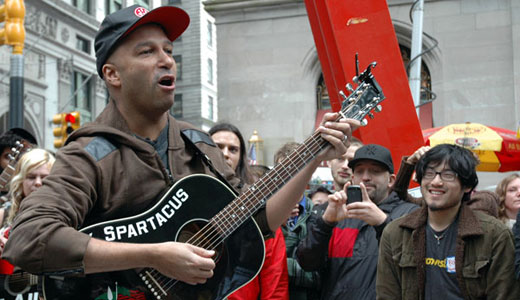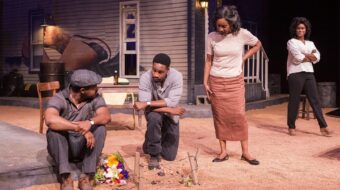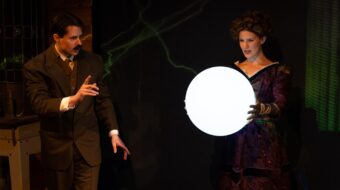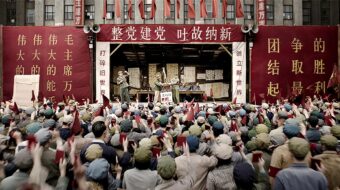
Every social movement has inspired artists to enlist their talents to create cultural expressions that in turn stir the masses and broaden the cause. Artists can bring their own social credibility to the movement, further legitimizing the struggle. For example, the nation-changing social movements of the 1960s – the antiwar and civil rights movements – came with their own soundtracks, including the music activism of artists like Nina Simone, Phil Ochs and Pete Seeger. These movements also drew in stars who previously weren’t identified as “political,” like John Lennon, whose celebrity in turn drew attention from audiences who may not have otherwise become engaged in controversial issues.
Similarly, the Occupy movement has provided an opportunity for musicians and performers of all styles and genres to speak up on behalf of the “99 percent,” and draw in the involvement of people who may not camp out in front of City Hall or identify as “activists.”
Music is a big component of the Occupy movement. One reason for this may be the large youth contingents involved. Another may be because the form of the protests themselves – Occupy Wall Street was originally ignited by the radical anti-consumerist arts and culture magazine AdBusters – is conducive to creativity and cultural expression.
The images evoked by Occupy (the 99 percent versus the 1 percent, injustice, police brutality, feelings of loss, despair and alienation) are definitely fodder for protest anthems. Some performers have been offering up existing songs from their catalogs; others have been writing new ones specifically for the occasion.
Of course, given the explosion of the sheer numbers of songs on YouTube, the quality of the efforts varies greatly. Musical novices provide endless acoustic guitar ballads over Ken Burns-style montages of protest scenes. Few and far between are the songs with extraordinary political incisiveness, passion and inventiveness. Still, that’s to be expected from a movement that’s grown like a mushroom. At least participants are energized and wanting to inspire others to join the cause, so it’s hard to be too critical. Here’s a roundup of some of the more noteworthy performances.
At over 250,000 views, Hawaiian singer Makana’s video of his song “We are the Many” is the most popular Occupy song on YouTube. Makana, of Occupy with Aloha, “crashed” the Asian-Pacific Economic Cooperation (APEC) dinner in November by performing this song. Some wondered how he “got away with it,” but Makana’s melodious slack-key guitar technique and placid delivery are eminently inoffensive. Makana’s playing and singing are nice, but the lyrics leave something to be desired:
From underneath the vestiture of law
the lobbyists at Washington do gnaw
at liberty, the bureaucrats guffaw
and until they are purged, we won’t withdraw
Makana “We are the Many” video
Beyond the awkward syntax and clumsy rhyme schemes, with a few tweaks the politically generic lyrical content could easily be that of a tea party protest song.
One of the heartening side effects of the Occupy music explosion is a resurgence of political rap. An outstanding example is Boots Riley of The Coup and Street Sweeper Social Club. For his performance at Occupy Oakland, he didn’t have Occupy-specific raps, but he didn’t need to. Boots did well enough just to recycle an a cappella version of his “Underdogs,” written during the Clinton administration:
Work six days a week, can’t sleep Saturday though
muscles tremblin’ like a pager when the batteries low
and you just don’t know where the years went
although every long shift feel like a year spent
Boots Riley performing “Underdogs” at Occupy Oakland
Preternaturally angry rapper Immortal Technique popped up at Zuccotti Park with a blistering impromptu excerpt from his “Toast to the Dead.” Emerging hip hop acts brought fresher beats and rhymes. Occupation Freedom, Ground Zero and the Global Block Collective collaborated on “Occupy Wall St. Hip Hop Anthem.” Occupy Denver’s Hip Hop collective featuring Mane Rok, Bravo One, Dyalekt, Aja Black, Jonny 5 (of The Flobots), and T Minus Katlyn delivered “The 99th Problem.” This diverse collective contradicts the image of Occupy as a homogenous, white middle class movement. Iraq veteran rapper Sgt Dunson, a crossover voice from the antiwar movement, took the occasion to pen “We are the 99 percent.”
One of the odder entries is “Mic Check! This is what Democracy Looks Like!” by Steve Bricks and Garret John, who helped start Occupy Boston. This techno club mix-type song breaks the typical protest song format, but relies a bit much on Auto Tune.
Alternative rockers also contributed protest jams. Tom Morello (Rage Against the Machine, Night Watchman, Street Sweeper Social Club) performed Woody Guthrie’s sing-along favorite “This Land is Your Land” and his own “World Wide Rebel Song” in an improvised street concert at Occupy Wall Street.
Tom Morello performing “This Land is Your Land” at Liberty Park
Amanda Palmer (of Dresden Dolls) contributed the quirky “The Ukulele Anthem,” an unexpected take on the energy fueling the Occupy movement. Punk rockers NOFX invited cops to join the movement and arrest crooked bankers via their “Occupy L.A.”
NOFX performing “Occupy LA”
For fans of a more mellow sound, there’s the Reggae groove of “Finally Here” by The Roaring (featuring Ari Herstand), the catchy-as-hell hook of “Occupy Wall Street” by Spencer Livingston, and “Smile,” by Jay Samel, a laid-back Jack Johnson-ish jam.
Also effective is Chloe Cornelius’ song parody “I’ll Occupy” (to the tune of Gloria Gaynor’s “I Will Survive”):
I first was pepper sprayed
just standing on the side
but it took me being blinded
to open up my eyes
To sum up, the wide variety of the music represented in the Occupy movement indicates the diversity of its participants, as well as the deep impact the movement has had on the broader culture.
Photo: Tom Morello at Occupy Wall Street. Chris Elliott/PW












Comments